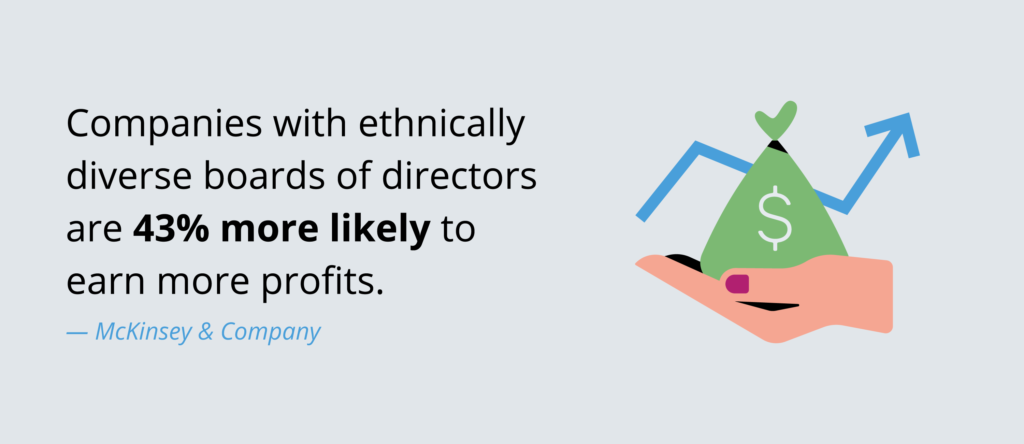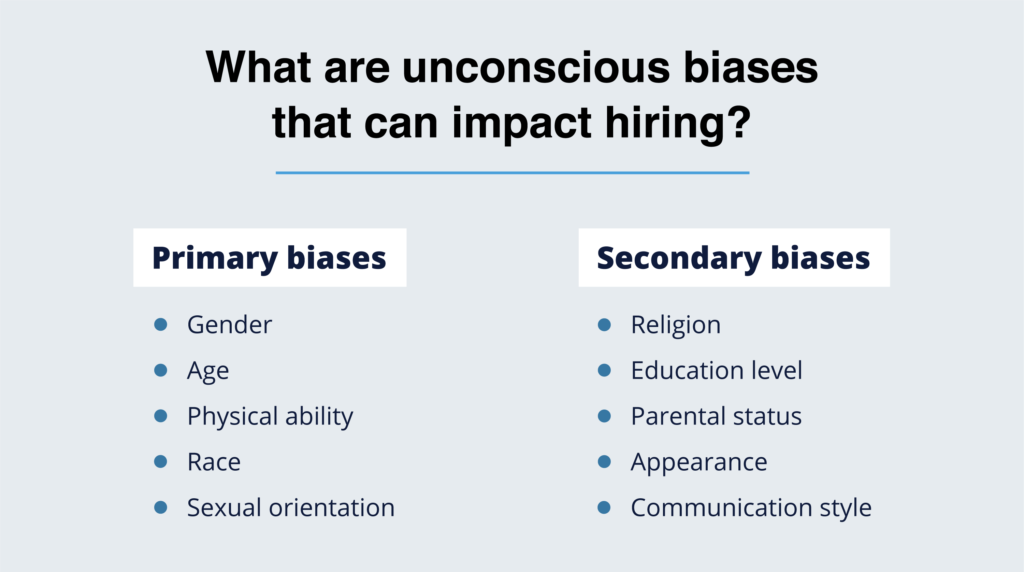There are many advantages to creating and maintaining a diverse workforce, and it’s important for employers to prioritize diversity and inclusion when building teams. Hiring a diverse group of employees can increase your bottom line, positively impacting everything from engagement to productivity and problem-solving.
But it isn’t enough to just hire diverse talent. To make your company a comfortable place for all to work and thrive, you may need to make some policy adjustments. Examining your current company structures and procedures can help you determine which areas might need a little more work.
To help you identify some of these problem areas — and the benefits of encouraging diversity for your business — we’ve put together this guide on diverse hiring and employee happiness.
What Is a Diverse Workforce?
A diverse workforce brings together people from different races, genders, backgrounds, ability levels, and life stages to work together. Basically, true workplace diversity means bringing a variety of experiences and backgrounds together to solve problems, increase productivity, and make everyone feel welcomed and valued.
Job board Indeed highlighted the following types of workplace diversity:
- Cognitive diversity: Your workforce brings together a variety of problem-solving techniques and thought processes to accomplish company goals.
- Lifestyle diversity: People’s experiences out of the office impact the way they perform and behave at work.
- Brand diversity: Companies attract diverse hires by being forthcoming with their diversity practices and commitment.

Benefits of a Diverse Workforce
Catering to diversity in the office has benefits ranging from the material to the emotional. In this section, we’ll explore just a few of the many ways that diversity drives results and why HR should source diverse talent.
Access to Specialized Talent
One of the main benefits of hiring internationally is access to a broader range of talent. This not only means access to more talent but also access to specific talent that may not be available locally. Different regions have different skill sets.
Based on data from The Organization for Economic Co-Operation and Development and the International Labor Organization, the Boston Consulting Group (BCG) estimates one in every two companies struggle to find employees with the right skill sets.
“Today, 1.3 billion people have competencies that either exceed or are insufficient for the activities they perform, and by 2030 there will be more than 1.4 billion.”
This skills gap is not an issue of lack of potential employees but rather a mismatch of their skills and the requirements of the role.
The OECD data shows in the US alone, 33.5% of workers are mismatched with their current position. A mismatch means extra time training, less efficient workflow, unhappy customers, or even the inability to move forward with projects. Remote work reduces the risk of a mismatch by opening up more options.
Local Knowledge and Languages
Hiring internationally can be daunting, particularly when you are entering an entirely new market. If you’re based in the US, you may be tempted to make the UK your Europe HQ as it feels more familiar to you than somewhere in say Eastern Europe. However, it’s important to realize, choosing what feels familiar to you may not always serve you the best.
By sticking to hiring in one country, or only in those that share your language, you’ll miss out on the specialized talent available from other locations.
According to a CEMS survey, “16% of HRs defined language and communication barriers as one of the major challenges when recruiting global talent,” but what if you viewed these differences as an asset instead?
When entering new markets with your business, it can be extremely helpful to have a local team who understands the culture, language, and business practices of their location.
Employees who speak multiple languages are an incredible asset to global teams, particularly those who are in service-based roles. In instances where clients and stakeholders may prefer to do business in their local language, having a native speaker might mean reducing your need for translation services, and where employees can speak multiple languages it could reduce your need to hire more people altogether.
While anyone can learn another language, multilingual people are more likely to come from countries where English is not their first language. Many countries have multiple official languages, often with hundreds of languages spoken regionally. For example, India has 22 official languages with 427 spoken across the country. Access to this range of communication is yet another benefit to hiring internationally.
So while language barriers and cultural differences may initially feel like a hurdle, hiring local teams may end up being one of your best business assets.
Increased Productivity
A diverse workforce is more productive. Different perspectives can help problem solve and create more profitable solutions to any hurdles or roadblocks that arise in business. But even beyond problem-solving, a diverse workforce can facilitate a happier and more engaged workplace that drives productivity by proxy.
It all starts with engagement — with millennials driving the workforce, they’re looking for companies that cater to diversity. Among millennials, 83% are actively engaged in their work when they feel they work for an inclusive company compared to just a 60% engagement rate when they feel their company doesn’t prioritize diversity.
Increased Revenue
A diverse workforce is more engaged, which means more work is getting done, and more profit is made. One report by McKinsey & Company found that companies with diverse boards of directors are 43% more likely to earn higher profits.
Similarly, another report from BCG found that more diverse management teams reported innovation revenue that was 19 percentage points higher than other companies — diverse companies reported 45% innovation revenue compared to the usual 26%. (Innovation revenue is the profit earned from new products, services, or ideas).
The lesson here is that diverse teams think creatively and work hard, leading to more profit and more innovation in the office.
New Perspectives in the Office
A variety of perspectives can facilitate new ideas, innovation, and strategy. Think about it this way: 2+2 = 4, but so does 3+1 and 6-2, etc. There are many ways to solve a problem, and each person will apply their learned life experience to it. Bringing a variety of life experiences to the job can lead to more creative decision-making and problem-solving.
Typically, decisions made by diverse teams will be smarter. Diverse teams outperform individual decision-makers 87% of the time and make decisions faster 60% of the time.
To reap the benefits of this smarter and more creative decision-making, bring diverse teams together. Foster teamwork among diverse groups to bring various perspectives together.
Increased Comfort for All Employees
Being the odd one out can be hard. People will feel more comfortable at work if they are surrounded by people who look like them. And what’s more: diverse companies are less likely to make any particular employee feel singled out or discriminated against.
Turnover rates are high. And for employees of color, these figures can be especially staggering. Nearly half of both Black and Hispanic employees — 47% and 49%, respectively — have left a job because they witnessed or experienced discrimination while at work.
The bottom line: if you want employees to feel comfortable and stick around, put an emphasis on diversity and diverse policies.
Challenges of Creating a Diverse Workplace
Unfortunately, simply wanting to create a diverse workplace won’t make it happen. It’s going to take work. Those who want to reap the benefits of diversity need to assess and refine their talent acquisition strategy with care and be willing to put in the work to get there.
Implementing Diverse Practices
Deciding you want to foster a more inclusive workplace might make you want to turn a complete 180 overnight. But doing too much too quickly can actually make you look performative or lead to miscommunications.
It’s best to approach diversity thoughtfully. Think your policies and messaging through, making sure everyone is on board and educated.
Training Management
As bad as it may be, majority-white companies have been the norm for a long time. So your management team may operate with an “if it isn’t broken, don’t fix it” approach. The first step is to let them know that a not diverse company is, technically, “broken.”
Training management about the importance of diversity is an important first step to integrating it into your organization as a whole. Make sure to put appropriate time on management’s calendar to make sure they understand the concepts and can practice diversity through their work.

Unconscious Bias
Biases can seep into many different aspects of your workforce, from hiring to day-to-day interactions. Being aware of and educating your team about these biases can help people become more aware of how they may be subconsciously making others in the office feel uncomfortable.
The basic breakdown of workplace biases is the following:
- Primary biases: Common biases include factors like age, gender, race, and sexual orientation.
- Secondary biases: Less noticeable biases that include factors like parental or marital status, religion, or accent.
How to Diversify Your Workforce
Diversity starts with intentional changes from people who care. You can start with education and inclusive policy changes that will make your business a more comfortable place to work.
Remove Bias From Hiring
Bias can seep into the hiring process without your hiring team even noticing. As a result, try blind hiring. Blind hiring is the practice of obscuring an applicant’s personal details to focus solely on their credentials. There are several technologies — like Blendoor and Textio, for example — that will obscure an applicant’s name and remove any demographic information. You can also conduct initial interviews via anonymous chat or email.
Another way to hire diverse is to go global. Global hiring can bring new perspectives, lifestyles, and people into your office. This can help you reap all the benefits of having a diverse office while also expanding your business to other parts of the world. This is especially possible now that many companies are accommodating full-time remote work.
Write a Mission Statement
According to Glassdoor, 76% of job seekers factor a company’s stance on diversity into their decision-making. Establishing your commitment to a diverse workforce throughout the hiring process can show prospective employees that you are focused on inclusivity.
Writing a mission statement in your job postings can help attract candidates who are looking for an inclusive company. In your mission statement, be sure to note that your posting is open to people of all races, genders, backgrounds, physical ability levels, and more.
Change Company Practices
Small changes can make a big impact. Rebranding your end-of-year Christmas party to a holiday celebration can make people who don’t celebrate Christmas feel more included in the festivities. Providing flexible hours or remote options for parents can help those with children feel confident in their job and ability to deliver.
Look at your company’s day-to-day operations and pinpoint areas that might be making people feel uncomfortable, or set up an anonymous feedback form to get insight straight from your workforce.
A few other ways to accommodate diverse hires are the following:
- Provide training materials in multiple languages
- Install ADA-compliant ramps and hallways
- Host after-work gatherings at places that don’t serve alcohol
- Be transparent about pay
- Give people breaks to pray, walk, rest, or take care of their other lifestyle needs
For more information on taking care of diverse employees, get in touch!
A diverse group of employees are the backbone of any company. Focusing on diversity can help improve the culture of your organization while also fostering productivity, innovation, and comfort for those who work there. Start by identifying problem areas and coming up with solutions, then move on to efforts like global hiring and policy overhauls.
Once you’re ready to go global, contact Velocity Global to streamline your human resources procedures with your entire team.
Frequently Asked Questions
What are the main benefits of diversity in the workplace?
In summary:
- Access to specialized talent
- Local knowledge and languages
- Increase productivity
- Increased revenue
- New perspectives in the office
- Increased comfort for all employees
What are the challenges of diversity in the workplace?
In summary:
- Implementing diverse practices
- Training management
- Unconscious bias



